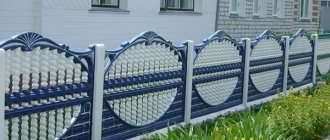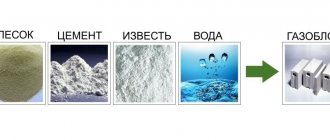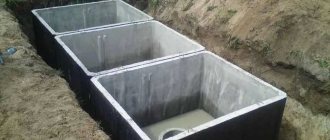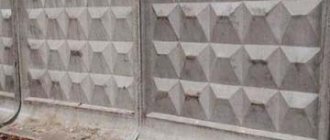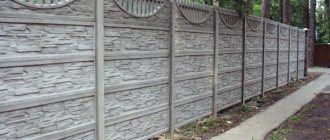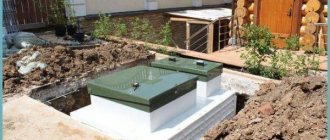Concrete fence
Progress has affected everything these days, even the execution of fences. Today, a fence is no longer a simple, even background along the perimeter of a site; modern fences are not just a protective structure, but also a beautiful decorative element, and sometimes even a striking work of construction art. As for concrete fences specifically, the most common types include the following:
- Monolithic,
- typesetting,
- Self-sufficient
- Decorative,
- Blocky.
Of course, using a flight of fancy and turning bold ideas into reality, you can arrange a completely individual design on your site, however, we are not talking about them. Let's consider only the most popular, constantly used types of concrete fences. Based on them, if desired, you can also show individuality and add zest to even the simplest fencing option.
What grade of concrete is needed for the foundation of a house, depending on the load?
- Concrete M200 for a building whose walls are made of rounded logs, timber, foam blocks, cinder blocks, wood concrete, gas silicate or expanded clay concrete blocks;
- Concrete M250 for brick buildings with concrete floors;
- Concrete M300 for two or three-story buildings with concrete floors.
It should be noted that the specified grades of concrete are given in the “not lower” format. This means that if the concrete grade M200 is recommended for the construction of a strip foundation, it is allowed to build a structure from grades M200, M300, etc. It’s just that the M200 brand is the most optimal in terms of the cost of the foundation and its ability to perform the functions assigned to it.
Monolithic fence
This is a serious building, a reliable support made of concrete, which does not care about any temporary adversity. Monolith is the most durable type of fencing; it will serve for many years and can withstand quite serious loads. Accordingly, this is a construction of solid weight and is performed only on a foundation - unlike other variations of concrete fences.
The foundation can be strip or columnar; they have different designs and can be made depending on the terrain on which the fence is installed, the available materials and the capabilities of the owners.
The only nuance that unites these types of bases for a monolithic fence: absolute compliance with the level of construction of the foundation. It must be aligned with the fence, no matter how flat or, conversely, hilly, in this case, the terrain. The slightest deviations from the foundation pouring level will inevitably lead to a gradual tilt of the fence and, accordingly, its premature destruction.
Strip foundation for a concrete fence
Manufacturing a strip foundation consists of the following steps:
- Digging a trench for the foundation. Its dimensions depend on the dimensions of the fence itself and on the type of soil on which it will be installed; in general, usually, the depth of the trench varies up to one meter.
- Installation of formwork. An important step is also the installation of the formwork - it is important to make it level to avoid damage to the structure in the future. To further strengthen the base, reinforcement or wire can be inserted into it.
- Pouring the foundation. The last point of work is pouring the ground part of the foundation.
Columnar foundation for a concrete fence
If a columnar foundation for a monolithic fence is planned, the following work will be performed:
- Wells are made for pillars for the foundation. Along the entire perimeter of the area where the fence will be installed, wells are made for pillars for the foundation. Usually they are dug at a distance of one and a half to two meters, but this, of course, depends on the size of the fence itself. The depth of the well can also be about one meter.
- Fastening supports. In the wells, supports are attached using mortar, crushed stone and sand - these can be pipes made of asbestos cement or other suitable material.
Such a foundation is perhaps simpler in execution than the first option - but not only ease of execution is important here, but also appearance and ease of execution in each specific area.
After making the foundation, the main task ahead is the installation of a monolithic concrete fence. This job cannot be done on your own, no matter how jack of all trades you are. First of all, the difficulty lies in the large weight of monolithic blocks; their delivery and installation requires special equipment and doing it manually is simply physically impossible.
You also need to take into account that only a professional builder can perform smooth and high-quality installation of blocks and their fastening to each other - with mortar and special fasteners.
The last stage is finishing the already installed monolithic fence - this can be decorating it with some type of material (brick, stone, etc.) or something more non-standard.
A monolithic fence is a rather difficult to manufacture, heavy and bulky structure, but at the same time, this type of concrete fencing is the strongest and most durable.
Production technology
The process of producing concrete fences is technically simple. This requires certain equipment, raw materials and, of course, knowledge of the production process. Let's look at it step by step.
Factory production process
To produce products you will need the following equipment:
- Various shapes designed for both the manufacture of pillars and slabs.
- The main equipment is a vibrating table. It is vibration technology that helps remove unwanted air bubbles that reduce the density of concrete.
- Vibrating sieve. It is used to clean raw materials from impurities. The better the result of such a process, the better the resulting concrete.
- Concrete mixer
The main components of the solution are cement and sand, which are sifted through a vibrating sieve; its cell size should not exceed 5 mm. Crushed stone, reinforcement and plasticizer are also used.
When the equipment is set up and the raw materials are ready, you can start working.
- The first step is preparing the mixture.
- At this time, the molds are prepared: they are cleaned and lubricated with a special composition.
- Next, the mixture is placed in molds and sent to a vibrating table to force the concrete to compact.
- To improve performance characteristics, various modifiers and plasticizers are added to the solution.
- Reinforcement is already placed into the compacted concrete and, under the influence of vibration, it sinks into the concrete.
- Afterwards, the products are rubbed down and errors are removed.
- The final stage is the unmolding of the slabs.
Production of concrete fences
Installation for the production of concrete fences
The pillars are made according to a similar principle:
- the forms are filled one third full and sent to the vibrating table;
- then 2 reinforcement bars are laid and subjected to vibration again;
- the solution is topped up and compacted again by vibration;
- Finally, 2 more reinforcement rods are inserted and the remaining solution is poured in.
Posts for concrete fences
Future concrete fence posts are unmolded; large enterprises have special equipment for this. In addition to pillars and slabs, additional elements are also manufactured, such as concrete caps for the fence, ebbs, and glasses.
The caps are fixed on top of the pillars and are the final decorative element. At the moment, quite large and popular manufacturers of concrete fences are located in Yelets and Luninets.
concrete fence caps
Making structures with your own hands
Making fences with your own hands is possible. However, it is worth following a certain set of rules in order to prevent irreversible consequences and obtain negative results.
The set of raw materials is still the same: cement, sand, water, reinforcement, crushed stone and additives - if desired. A vibrating table can be purchased in special stores or you can build it yourself. In this case, the savings will be significant.
The production principle is similar to the factory one, the only difference is increased labor costs due to the lack of automated machines and possible errors in dosing the proportions of components. And also the impossibility of quality control, with the exception of the external characteristics of products.
Particular attention should be paid to the composition of the solution: the sand must be cleaned, cement grade is not lower than 400.
Stacked fence
It is much easier to implement and can be done independently, if the owner has the desire and minimal skills in construction techniques.
In fact, a stacked fence is a structure consisting of small concrete blocks, from which the required height and length of the fence is assembled. The height of such panels is most often three or four, depending on the needs or wishes of the Customer.
The concrete blocks from which the structure is assembled are usually sold already decorated - with a stone or brick finish, or another fancy type of design. The most popular are these models, where the lower two or three blocks are made in the same style - solid, with the same finish, and the upper block has special decorative gaps or patterns.
This design looks light, not overloaded, and visually attractive. If necessary, of course, you can install a continuous high fence made of stacked concrete blocks.
The installation of such a structure is quite affordable for a team of several people. The approximate weight of one section varies between thirty and fifty kilograms and no special construction equipment is needed to unload and install it. To install the blocks, special posts with grooves are used.
A prefabricated concrete fence can be made either with or without a preliminary foundation - high-quality execution is possible in both cases and depends only on the conscientiousness of the builders.
Prefabricated fences are also convenient because they are sold already decorated - and you need to make a choice on the design at the stage of ordering blocks for the fence. The appearance of such fences presented on the domestic market varies from the simplest to the unusual and even made according to an individual sketch.
Decorative finishing can be done on both sides of the fence or only on one side - the outer one.
When choosing this type of concrete fence, always pay attention to the quality of the prefabricated blocks. It is important to note here that there are no cracks, chips or other similar defects in the cast products. Also, do not be lazy to inquire about the brand of concrete from which they are made and whether the reinforcement process has been completed - without this, the strength of the finished fence will decrease many times.
A prefabricated concrete fence is much lighter than a monolithic one, easier to construct, and, accordingly, cheaper in price. Of course, its strength is inferior to a monolithic structure, however, with careful handling, high-quality installation and the original material, such a fence will last a long time. It is also convenient that if the need for repair does arise, in such a design it is possible to replace only those sections that are out of order, and not to completely redo the entire fence.
Please note that you need to take care of the availability of spare (replaceable) sections in advance, at the stage of ordering material for installing the fence - otherwise, exactly the same blocks may simply not be available.
Useful tips for installation without the involvement of specialists
If you decide to install the fence yourself without involving construction crews, use the following tips:
- Try to avoid installing a fence in winter. Due to the negative temperature, the solution sets slowly due to the fact that the water freezes quite quickly. If it is impossible to delay until spring, it is recommended to use warm water and special additives that stimulate setting.
- Pay close attention to the process of preparing the solution, follow the technology and proportions of materials. Particularly important is the consistency of the cement grade.
- If the site is located on a hill or in a lowland and there is a slope, a stepped foundation is recommended. This will save materials.
- When purchasing structures for fencing, try to pay attention to trusted manufacturers, since, unfortunately, there are not so few handicraft productions. Too low a price should confuse you. In this case, it would be relevant to remember the well-known saying that the miser pays twice.
- If you are not sure that you can handle the job, it is better to seek help from specialists.
DIY concrete fence installation diagram
Self-standing concrete fence
This is perhaps a separate type, which is used in fairly rare cases. A self-standing fence consists of solid reinforced concrete slabs of large weight and dimensions - it is not particularly attractive, however, it has the highest strength among all types of concrete fences.
A distinctive feature of a self-standing concrete fence is that its installation, although it is very heavy, does not require a separate foundation. In this case, monolithic slabs are installed directly on their base, which is made in a special way - it has a horizontal plane.
Sometimes the method of installing slabs on special “glasses” is used, which serve as the basis for such a fence.
Self-standing concrete fences are usually used for fencing industrial or construction sites, production areas or warehouses. The construction of such a fence will not be difficult or require special preparation; of course, this is only true if you have special lifting construction equipment, as well as any territory that needs reliable and durable fencing.
Special coatings
Everyone knows that metal products are not friendly with excess moisture. It leads to the formation of rust. To extend the service life of the fence and protect it from various negative factors, various compositions and solutions are used.
Experts assure that in the area of welded joints the metal is subject to intense corrosion. This is due to carbon loss. To prevent unpleasant consequences, various processing technologies are used.
There are several methods for coating a product with a special composition:
- Powder coating.
- Galvanic method.
- Application of polymers.
Decorative concrete fence
To some extent, decorative fences include prefabricated concrete fences and the so-called Eurofences - since they not only carry the function of fencing the territory, but also to a large extent decorate the site. In general, by the name of a decorative concrete fence we mean a fence made using the artistic casting technique.
This type of fencing can be made in any style, color and size. Here, the appearance of the finished product depends entirely on the wishes of the Customer. Many manufacturers cast fences according to individual sketches, but there are even a lot of standard varieties - popular sellers of decorative concrete fences have in their arsenal two hundred to three hundred types of artistic casting, shades and shapes of fencing.
It is also possible to combine a cast concrete base with other materials - this also adds an additional twist to the design. The concrete fence can be supplemented with decorative forging, wooden elements or other decorations, at the request of the client.
More about decor
Many people choose natural stone relief. But the following types of imitations have become popular:
- Logs or beams;
- Solid brick, stone masonry;
- Branches of various trees.
There are more complex designs made from several types of blocks. In appearance and properties, they practically do not differ from the base made of natural stone. A lattice or baluster are elements that often decorate the upper part of the fence. If the texture and color are chosen correctly, it is difficult to immediately tell what material is used in the base.
Original ideas include the use of openwork patterns, imitations of bamboo and pink weaving.
Decorating the structure allows the use of different techniques:
- Imitation of hedges;
- Art exhibitions, original graffiti, drawings with cartoon characters;
- Tiles, stone or special panels imitating different materials;
- Combination with forging.
The main thing is not to overdo it with variegated flowers. It is recommended to give preference to natural shades.
Block concrete fence
Here the name speaks for itself - a block fence, accordingly, is made of blocks. They can be hollow or monolithic - depending on the needs and cost of materials. To install the blocks you will not need special posts - as for stacked fences, here the blocks are attached to each other using mortar and special “bandages”.
For this type of fence, a preliminary installation of a strip foundation is required. How to build it has already been discussed above, and its size will directly depend on the thickness of the blocks you choose. The depth of the trench under the foundation is also more or less standard and will be about one meter.
The blocks are laid on the foundation, secured with mortar and dressings; each subsequent row of blocks must be offset along the vertical seam to ensure the stability of the structure. The optimal displacement of the seams would be about thirty percent of the size of the block itself - this trend is relevant for each subsequent row.
Block fences require mandatory decorative finishing to visually hide the attachment points. The most common types of finishing of concrete blocks are decorative plaster for facades - of various textures and colors, or tiling to look like brick or other material. Typically, finishing is carried out some time after the construction of the structure, allowing it to completely harden and dry. In the warm season, this period can take about a week, in cooler weather - two or three.
Also, some manufacturers of concrete blocks for fences offer customers ready-made decorative blocks that do not require additional finishing after installing the fence - they are already ready and finished with stone, brick or decorative casting and painted. The choice of color and shape for such blocks is very diverse and makes it possible to choose an option to suit any style of building facade.
Concrete fences are reliable, durable and, if desired, beautiful. It should be noted that basically all structures are made double-sided, that is, identical both on the front side and on the inside, however, if there is a need for savings, then one-sided design is also possible.
As for the sizes, naturally, they can fluctuate within the limits required by the client. As a rule, when constructing concrete fences, the height fluctuates around two meters, and block or stacked types can be of any height.
To summarize, it is important to note that a concrete fence has a lot of positive aspects:
- Strength,
- Weather resistance,
- Durability,
- Practicality,
- Easy to maintain
- Possibility of various decorative finishes,
If you pay attention to the disadvantages of concrete fences, then you can highlight the following nuances:
- Installing a concrete fence almost always requires a preliminary foundation,
- Concrete blocks, hollow or monolithic, for set models - yes, in principle, almost all of them have a decent weight, they are quite difficult to transport and install. Some types of concrete fences can only be installed using special construction equipment.
- The cost of a concrete fence will naturally be higher than a wooden or, for example, metal one.
- The amount of work is also greater when compared with some other materials.
Nevertheless, concrete fences were, are and remain in demand - both ready-made and custom-made. And this is logical, because, even taking into account its cost, a concrete fence is a fence that will serve for decades. Having built it once, you can forget about worries about fencing the site for many years.
Advantages of concrete fencing, features and disadvantages
A fence made of reinforced concrete sections is in demand and popular. This is due to the following advantages:
- Reliability. The slabs are reinforced with reinforcement, so the load-bearing capacity increases. Such a product can withstand enormous loads, given its small thickness;
- The fence reliably protects from prying eyes, noise and dust;
- Long service life;
- Appearance. A fence can be attractive thanks to its design. The surface is decorated with plaster or tiles, natural stone;
- Mobility of the structure. If necessary, the structure can be easily disassembled and moved to another area. This is especially true for sectional fences. The number of installations and dismantlings is not limited;
- No gaps, cracks or distortions. The slabs and sections are connected so that the joints are invisible;
- Fire resistance;
- Environmental friendliness;
- Moisture resistance;
- Fast installation process;
- Lack of special care;
- Resistance to external factors;
- It is not always necessary to organize a foundation;
- Saving money when comparing the installation of concrete fencing with other types of fences.
After all the above advantages, a significant disadvantage can be noted - the fence does not allow air to pass through well. This problem can be solved by inserting openwork elements or creating a special gap.
A few more minor cons:
- Installing a concrete fence will cost more than a fence made of wood or metal;
- Often, installation work requires special equipment;
- Organization of the foundation. This is an additional cost in time and money.
Decoration
The term "decoration" can be called finishing. This is the process of modifying a fence slab using design skills and tools. This is done to achieve a clear goal - to make the appearance of the structure more interesting and attractive.
Constantly seeing a block of reinforced concrete in front of you in its primary color - gray, can get boring. Therefore, paints are used that give a brighter or calmer look to stucco. Decorative bricks or tiles are used. Such barriers are found in private homes. You can also see reinforced concrete fences in parks or squares, which are specially surrounded by such attractive fences.
When decorating a reinforced concrete fence around the house, the owner needs to constantly monitor the condition of the design additions - update the paint, monitor the reliability of the tiles.
